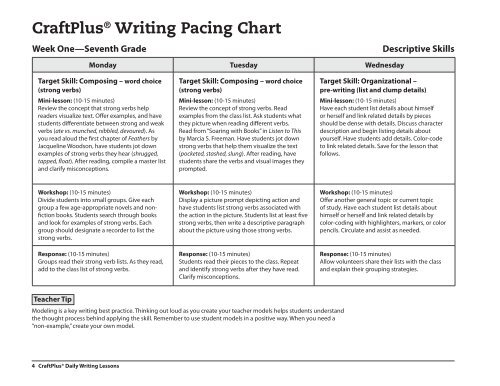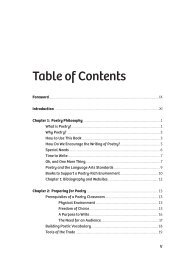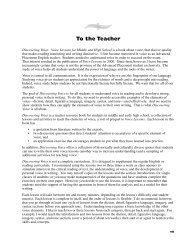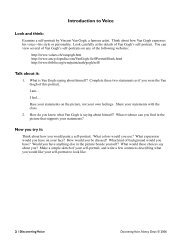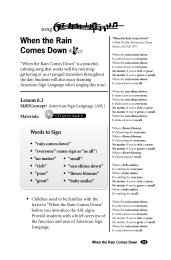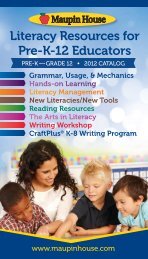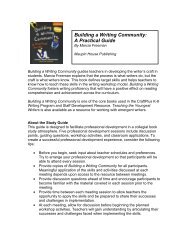Preview - Maupin House Publishing
Preview - Maupin House Publishing
Preview - Maupin House Publishing
You also want an ePaper? Increase the reach of your titles
YUMPU automatically turns print PDFs into web optimized ePapers that Google loves.
CraftPlus ® Writing Pacing Chart<br />
Week One —Seventh Grade Descriptive Skills<br />
4 CraftPlus® Daily Writing Lessons<br />
Monday Tuesday Wednesday<br />
Target Skill: Composing – word choice<br />
(strong verbs)<br />
Mini-lesson: (10-15 minutes)<br />
Review the concept that strong verbs help<br />
readers visualize text. Offer examples, and have<br />
students differentiate between strong and weak<br />
verbs (ate vs. munched, nibbled, devoured). As<br />
you read aloud the first chapter of Feathers by<br />
Jacqueline Woodson, have students jot down<br />
examples of strong verbs they hear (shrugged,<br />
tapped, float). After reading, compile a master list<br />
and clarify misconceptions.<br />
Workshop: (10-15 minutes)<br />
Divide students into small groups. Give each<br />
group a few age-appropriate novels and nonfiction<br />
books. Students search through books<br />
and look for examples of strong verbs. Each<br />
group should designate a recorder to list the<br />
strong verbs.<br />
Response: (10-15 minutes)<br />
Groups read their strong verb lists. As they read,<br />
add to the class list of strong verbs.<br />
Teacher Tip<br />
Target Skill: Composing – word choice<br />
(strong verbs)<br />
Mini-lesson: (10-15 minutes)<br />
Review the concept of strong verbs. Read<br />
examples from the class list. Ask students what<br />
they picture when reading different verbs.<br />
Read from “Soaring with Books” in Listen to This<br />
by Marcia S. Freeman. Have students jot down<br />
strong verbs that help them visualize the text<br />
(pocketed, stashed, slung). After reading, have<br />
students share the verbs and visual images they<br />
prompted.<br />
Workshop: (10-15 minutes)<br />
Display a picture prompt depicting action and<br />
have students list strong verbs associated with<br />
the action in the picture. Students list at least five<br />
strong verbs, then write a descriptive paragraph<br />
about the picture using those strong verbs.<br />
Response: (10-15 minutes)<br />
Students read their pieces to the class. Repeat<br />
and identify strong verbs after they have read.<br />
Clarify misconceptions.<br />
Modeling is a key writing best practice. Thinking out loud as you create your teacher models helps students understand<br />
the thought process behind applying the skill. Remember to use student models in a positive way. When you need a<br />
“non-example,” create your own model.<br />
Target Skill: Organizational –<br />
pre-writing (list and clump details)<br />
Mini-lesson: (10-15 minutes)<br />
Have each student list details about himself<br />
or herself and link related details by pieces<br />
should be dense with details. Discuss character<br />
description and begin listing details about<br />
yourself. Have students add details. Color-code<br />
to link related details. Save for the lesson that<br />
follows.<br />
Workshop: (10-15 minutes)<br />
Offer another general topic or current topic<br />
of study. Have each student list details about<br />
himself or herself and link related details by<br />
color-coding with highlighters, markers, or color<br />
pencils. Circulate and assist as needed.<br />
Response: (10-15 minutes)<br />
Allow volunteers share their lists with the class<br />
and explain their grouping strategies.
Thursday Friday Instructional Notes<br />
Target Skill: Organizational – thesis<br />
statement (generalize with details)<br />
Mini-lesson: (10-15 minutes)<br />
Review the importance of details in the body of<br />
a writing piece. Reread the descriptions of Trevor<br />
from the last long paragraph of the first chapter<br />
of Feathers by Jacqueline Woodson. Discuss the<br />
way the last sentence of the paragraph forms a<br />
general conclusion thesis statement about Trevor<br />
(others are afraid of him). Reread each group of<br />
related details from your personal description<br />
model created during the previous lesson. Work<br />
with students to write a thesis statement that<br />
draws generalizations about each group of<br />
related details.<br />
Workshop: (10-15 minutes)<br />
Students will write a general-conclusion thesis<br />
statement about each group of details, based on<br />
the color-coded groups of related details from<br />
personal description lists created during the<br />
previous lesson.<br />
Response: (10-15 minutes)<br />
Allow volunteers to share their thesis<br />
statements with the class. Identify thorough lists<br />
and logical linking of details.<br />
Crosswalk<br />
CD: Handouts-Boring paragraph 1, Peer conferencing;<br />
High-Frequency Word List.<br />
Assessment: word choice (strong verbs),<br />
pre-writing, thesis statement<br />
Mini-lesson: (5-10 minutes)<br />
Review strong verbs and thesis statements.<br />
Review the first few steps to writing a descriptive<br />
piece about yourself (list details then clump<br />
them, form thesis statements). Verbally model<br />
how you would use your details and thesis<br />
statements to write a descriptive piece about<br />
yourself, being sure to add strong verbs.<br />
Workshop: (20-25 minutes)<br />
Students write a descriptive piece about<br />
themselves using their groups of related details<br />
and thesis statements. Students should include<br />
at least five strong verbs in their pieces.<br />
Response: (5 minutes)<br />
Collect and score pieces using a multiple-skills<br />
rubric.<br />
•<br />
•<br />
•<br />
•<br />
•<br />
•<br />
Have partners interview each other, then use<br />
the information to write descriptive pieces<br />
about each other.<br />
Give students categories to use in listing<br />
details about themselves (appearance, talents,<br />
interests) and have them list details and write a<br />
thesis statement for each.<br />
Conventions<br />
Capitalization (first word in sentence, dialogue,<br />
proper noun, date, the word “I”)<br />
End marks (exclamation mark, period, question<br />
mark)<br />
Name/date on paper (continue throughout year)<br />
Noun (common, proper)<br />
Sentence structure (simple, compound,<br />
complex)<br />
Subject/predicate review<br />
• Verbs (strong; linking + strong and -ing)<br />
• Usage: it’s/its; they’re/their/there<br />
•<br />
Write complete sentences (fragment vs.<br />
sentence; run-on)<br />
Alternative literature model suggestion: Over the course of this week, read the first two<br />
chapters of The Bad Beginning by Lemony Snicket. Identify strong verbs (skip, construct,<br />
perished) and thesis statements. (Of course, it didn’t make things any easier that they had lost<br />
their home as well, and all of their possessions; Their home destroyed, the Baudelaires had to<br />
recuperate from their terrible loss in the Poe household, which was not at all agreeable.) Point<br />
out that the details following thesis statements presented at the beginnings of paragraphs<br />
support the generalization made by the thesis statements. Review the details used to<br />
describe Count Olaf and have students construct a thesis statement about this character.<br />
Seventh Grade / Week One 5


